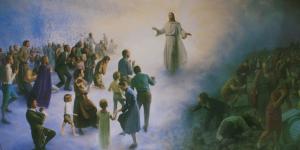You are here
Book of Mormon Central is in the process of migrating to our new Scripture Central website.
We ask for your patience during this transition. Over the coming weeks, all pages of bookofmormoncentral.org will be redirected to their corresponding page on scripturecentral.org, resulting in minimal disruption.
Gospel Doctrine Lesson #30: The Great Plan of Happiness

Scripture Block
Alma 40-42
To help class members gain a greater understanding of life after death and the mercy that is available to them through the Atonement of Jesus Christ.
Lesson Manual
KnoWhys
Multimedia
Video: BYUtv Discussions on the Book of Mormon: Alma 40-41. Available at BYUtv.org
Video: BYUtv Discussions on the Book of Mormon: Alma 42. Available at BYUtv.org
Video: Interpreter Scripture Roundtable: Book of Mormon Gospel Doctrine Lesson 30
Chart 36: "Nephihah as Chief Judge: Years 9-24 of the Reign of the Judges" from Charting the Book of Mormon.
Chart 54: "Key Doctrinal Chapters: Mosiah-Alma" from Charting the Book of Mormon.
Chart 74: "The Ways of Life and Death: Alma the Younger's Explanation to Corianton," from Charting the Book of Mormon.
Chart 145: "Nephite Cycles: Years 1-49 of the Reign of the Judges" from Charting the Book of Mormon.
Articles
John Hilton III, "Textual Similarities in the Words of Abinadi and Alma's Counsel to Corianton," BYU Studies Quarterly 51, no. 2 (2012): 39-60.
John Hilton examines textual similarities between two texts found in the Book of Mormon: the words of Abinadi in Mosiah 12–17 and the words of Alma the Younger in Alma 39–42. Hilton used both human-based and computer-based techniques to search for textual matches.
B. H. Roberts, "A Nephite's Commandments to His Sons - III. Corianton, II. - Concluded," Improvement Era 3, no. 11 (1900): 835-843.
B. H. Roberts provides a turn of the century perspective on the powerful teachings found in Alma 39-42. He examines and discusses the doctrine of resurrection and restoration found within these rich chapters.
George Q. Cannon, "The World of Spirits," The Juvenile Instructor 26, no. 2 (June 1 1891): 353-354.
George Q. Cannon provides a nineteenth century pespective on Alma's counsel to Corianton. This two-page piece consists of Cannon's editorial thoughts on Alma 40:11-12
Philip A. Allred, "Alma's Use of State in the Book of Mormon," in Pressing Forward with the Book of Mormon: The FARMS Updates of the 1990s, John W. Welch and Melvin J. Thorne, eds. (Provo, UT: FARMS, 1999).
In Alma's counsel to Corianton, he speaks of a person's state when they enter the presence of God at final judgment. Alma’s unique concentration of state, his tendency to reword with state, and his distinctive treatment of a shared topic involving state all point to him as a unique writer within the Book of Mormon.
H. Donl Peterson, "I Have a Question: What is the meaning of the Book of Mormon scriptures on eternal hell for the wicked?," Ensign (April 1986).
The Book of Mormon contains many teachings about final judgment and the fate of the wicked. Alma 39-42 in particular provides many doctrinal gems for readers on the nature of final judgment. H. Donl Peterson disucsses the interpretation of these scriptures to help readers understand God's plan for his children.
Philip A. Allred, "Notes and Communications: Alma's Use of State in the Book of Mormon: Evidence of Multiple Authorship," Journal of Book of Mormon Studies 5, no. 1 (1996): 140-146.
Alma’s distinctive use of the word state in the Book of Mormon is present in his unique concentration of state, his tendency to reword with state, and his treatment of a shared topic involving state.
Robert J. Matthews, "The Doctrine of the Resurrection as Taught in the Book of Mormon," BYU Studies Quarterly 30, no. 3 (1990): 41-56.
The Book of Mormon adds an enormous amount to our understanding of the realities, purposes, and process of the resurrection. It is one of the greatest gifts of God to all mankind. And as Alma teaches his son Corianton, God's mercy consists in giving people time to repent in preparation for the day of final judgement and resurrection.
Monte S. Lyman, "The State of the Soul between Death and the Resurrection," in The Book of Mormon: Alma, the Testimony of the Word, edited by Monte S. Nyman and Charles D. Tate, Jr. (Provo, UT: Religious Studies Center, 1992), 173-194.
There are six verses in Alma 40 that teach directly about the spirit world. This article analyzes these verses, attempting to answer any questions that may have arisen from them.
Richard O. Cowan, "A New Meaning of 'Restoration': The Book of Mormon on Life after Death," in The Book of Mormon: Alma, the Testimony of the Word, edited by Monte S. Nyman and Charles D. Tate, Jr. (Provo, UT: Religious Studies Center, 1992), 195-210.
God's prophets have promised a restoration of all things. When we hear the term restoration, we typically think of the latter-day return of the church and the revelation of the gospel in its fulness. Book of Mormon prophets, however, sue this term in a rather different sense. They teach that every individual will receive a temporal as well as a spiritual restoration, good for good, evil for evil.
Joseph Fielding McConkie, "A Comparison of Book of Mormon, Bible, and Traditional Teachings on the Doctrines of Salvation," in The Book of Mormon: The Keystone Scripture, edited by Paul R. Cheesman, S. Kent Brown, and Charles D. Tate, Jr. (Provo, UT: Religioius Studies Center, 1988), 73-90.
This paper will compare the teachings of the Book of Mormon, the Bible, and Christian tradition on doctrines essential to salvation. It will contrast the completeness and clarity with which these doctrines are taught in the stick of Judah and the stick of Joseph.



